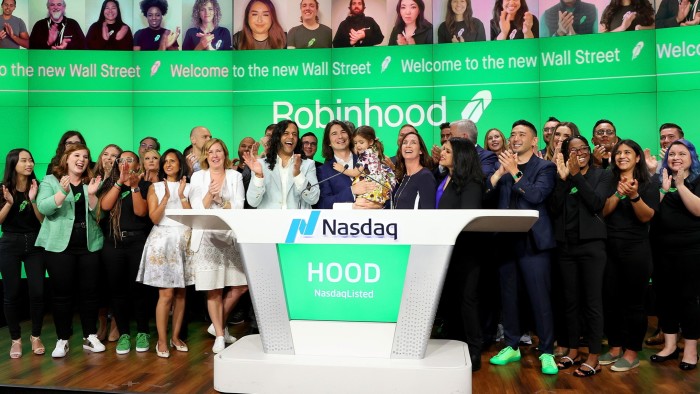When Robinhood reports full-year earnings on Wednesday, it will mark a coming of age for the engine of 2021’s fleeting meme stock mania.
Analysts anticipate fourth-quarter profits of more than double any previous quarter off the back of a blowout period for rivals. The online broker is expected to report its first-ever annual profit, more than three years after it first went public.
After shedding 80 per cent of its market capitalisation in the wake of its IPO, its shares have more than quadrupled over the past year, far outpacing rivals such as Interactive Brokers and Charles Schwab. It now trades 40 per cent above its IPO price, with a market value closing in on $50bn.
“The maturation of Robinhood has coincided with the maturation of the retail investor,” said Patrick Moley, an analyst at Piper Sandler. “They’ve been working on their product road map, so as retail trading has accelerated, they had these . . . pieces in place.”
Robinhood has evolved from an app that sprayed digital confetti when customers made their first trade to one that aims to serve as a broader financial services platform.
Its founder Vlad Tenev has set ambitious goals for the broker’s expansion. “We expect to get to number one in options before 2027, number one in equities before 2029,” he said at the company’s first investor day in December. “This is just one piece of a much larger picture.”
Revenues from trading have not yet recovered to the peak reached during 2021’s meme-stock mania. But since 2022, its earnings have been bolstered by rising interest rates, which have helped it earn interest on its own deposits as well as boosting its cash sweep programme, where it collects fees from customers who earn interest on their unused funds.

Last year, it added futures trading and a desktop app for more serious traders, as well as a credit card with a 2mn-strong wait list under its fee-paying “Gold” service.
“The card is the one that generates a lot of envy and interest around the office,” said Benjamin Budish, an analyst at Barclays who switched to an “overweight” rating on the stock in September.
A Robinhood Gold card currently offers an industry-leading 3 per cent cashback on all purchases, and select clients can apply for a solid gold version.
“We’re not yet seeing it driving a ton of revenues, but that wait-list is a lot of people who can become fee-paying clients,” Budish added. “With that, maybe they become equity clients — they maybe trade options. And then this platform approach starts to make more and more sense.”
For the quarter it is about to report, analysts expect $535mn in transaction-related revenues, according to LSEG data — a number that would finally surpass the meme-mania peak.
But this time revenues would be driven not by stocks — or even options trading, typically the largest source of income — but a surge in crypto trading income to $320mn from $61mn in the previous three months, after Donald Trump’s election as US president in November raised hopes for a crypto-friendly administration.
The potential for a sustained boom in crypto-related trading has been one of the factors driving the increase in Robinhood’s shares. But the gains have outstripped those of crypto specialist Coinbase. In the three months since the US elections, Coinbase’s shares have jumped almost 50 per cent, giving it a market capitalisation of $70bn. Robinhood’s shares have more than doubled.
“They’ve been very conservative with the number of tokens they offer — it’s about 20 and Coinbase has more than 250,” said Moley of Piper Sandler. “Robinhood has the ability to scale their crypto business while also having other asset classes. You can trade crypto, Nvidia options and the latest meme stock. That’s a model that I think is going to be successful for them over the next several years.”
In June, Robinhood paid $200mn for crypto exchange Bitstamp, a deal that could help it launch related services such as staking, a popular practice where coin owners agree to use their holdings to help verify other transactions, earning a return from which a broker takes a commission.
“We expect Robinhood to be the biggest beneficiary of crypto regulatory tailwinds,” said Gautam Chhugani, an analyst at Bernstein.
Robinhood remains a comparative minnow in the broking world, however with $195bn of assets under custody as of November. Interactive Brokers, its fiercest rival for online active traders, held $591bn as of January.
Brokers also face competition from far bigger wealth management players who can offer trading alongside a greater array of savings products and investment opportunities. Fidelity and Charles Schwab have some $15tn and $10tn in client assets, respectively.
That has raised fears that Robinhood’s clients, who tend to be younger, will “graduate” to bigger rivals with more to offer as they grow older and wealthier. On an earnings call last month, Schwab’s new chief executive, Rick Wurster, emphasised that a third of its new retail investors were under 30, and half were under 40.
While there are a multitude of financial products Robinhood could target to take on its more established competitors and lock investors into its platform — from investment advice and selling mutual funds, to the ability to host 401(k) plans, a key form of US pension management — the gulf between the rivals is large.
“Maybe it’s an unfair comparison, because Schwab and Fidelity are very mature platforms [and] the path to product parity with someone like a Schwab is very, very long,” said Barclays’ Budish.
“Is it all going to work? No. But seeing the company mature, I’m kind of more willing to give them the benefit of the doubt.”
https://www.ft.com/content/72c164f8-2c25-4499-9bc2-81053278084e


